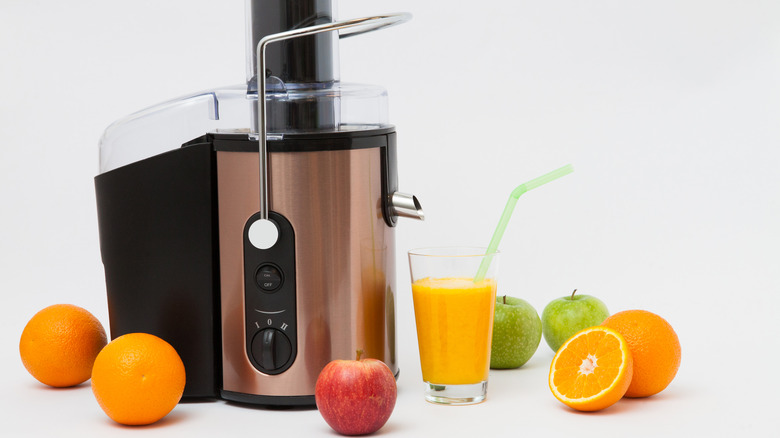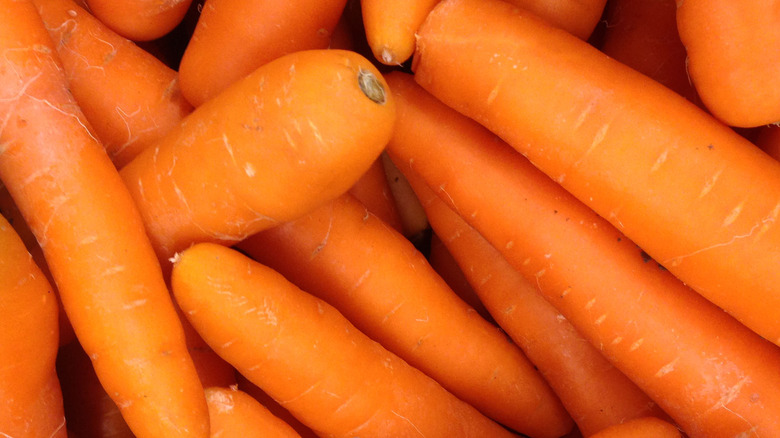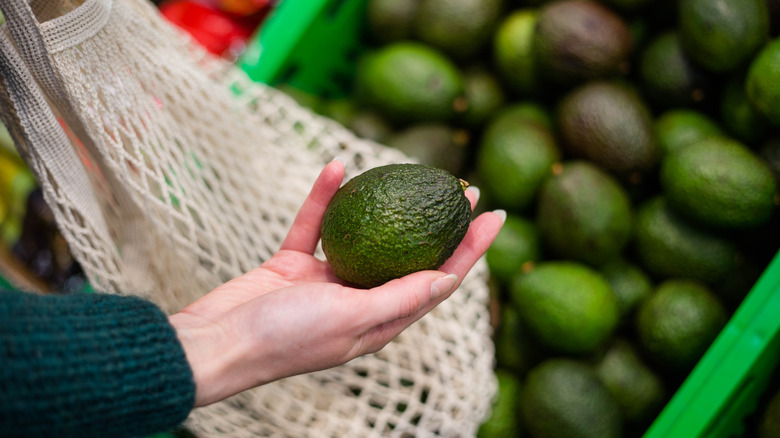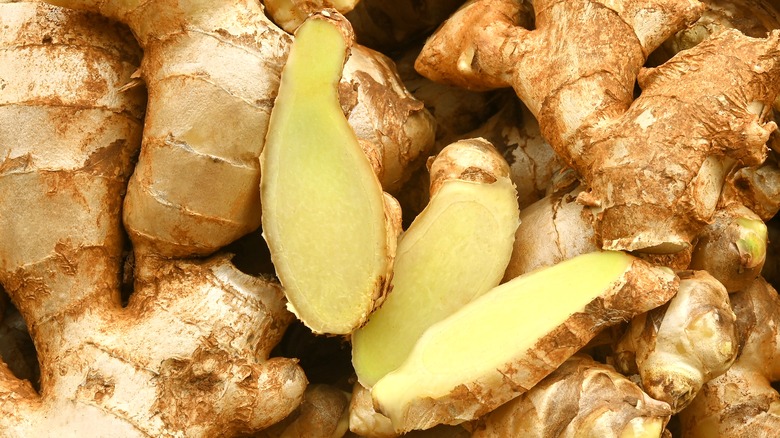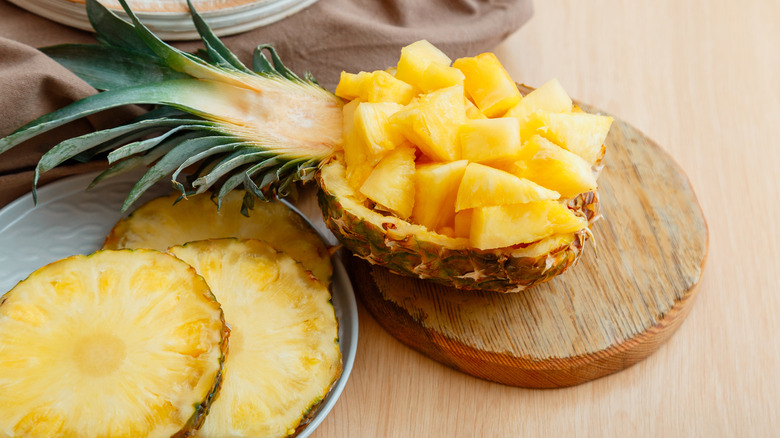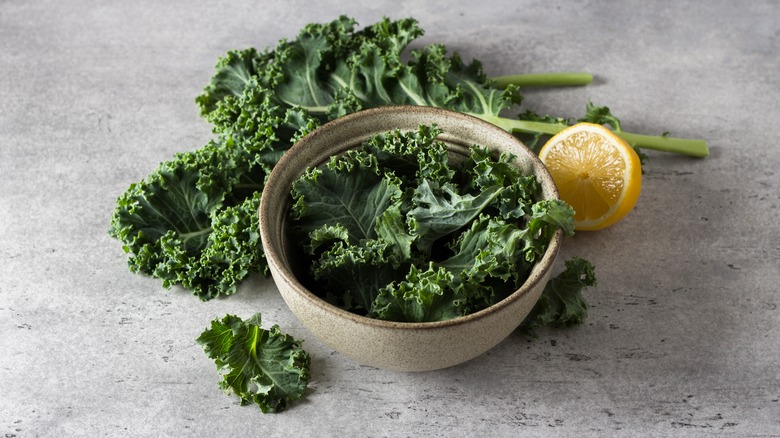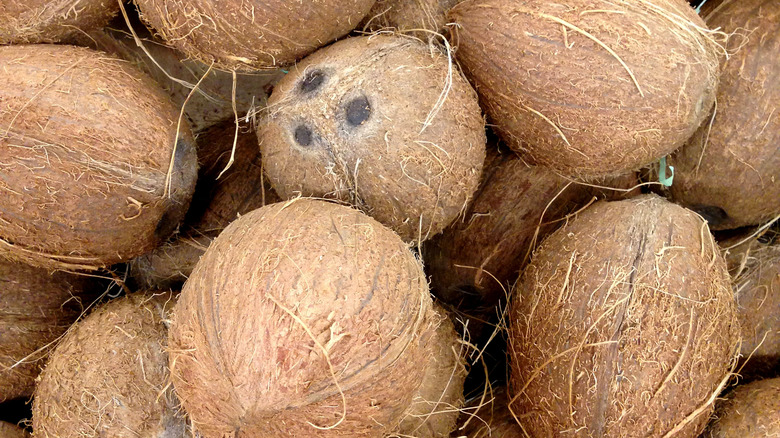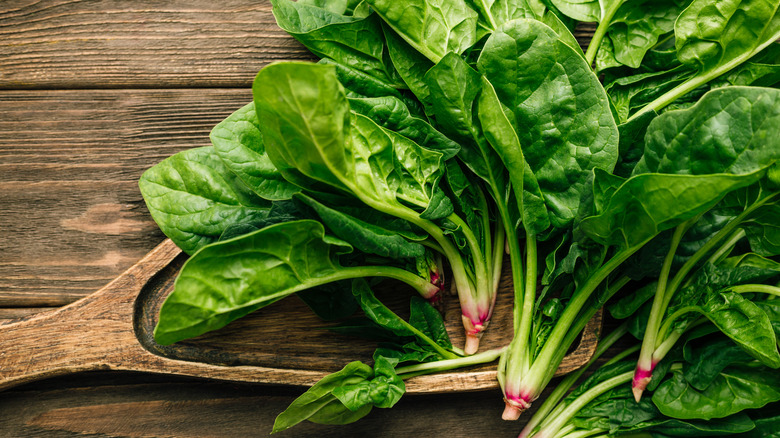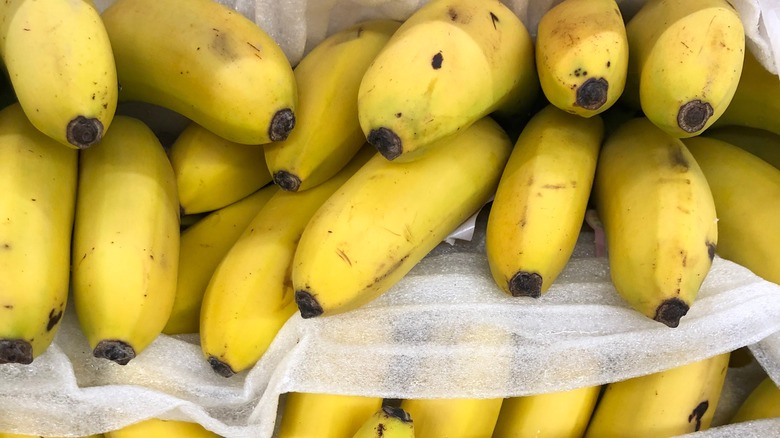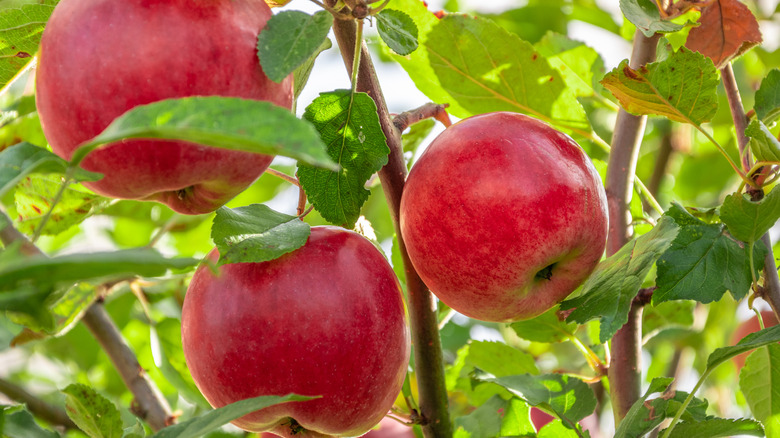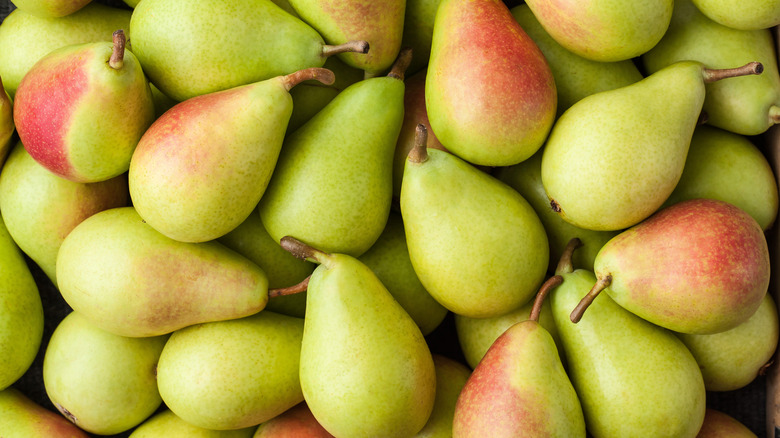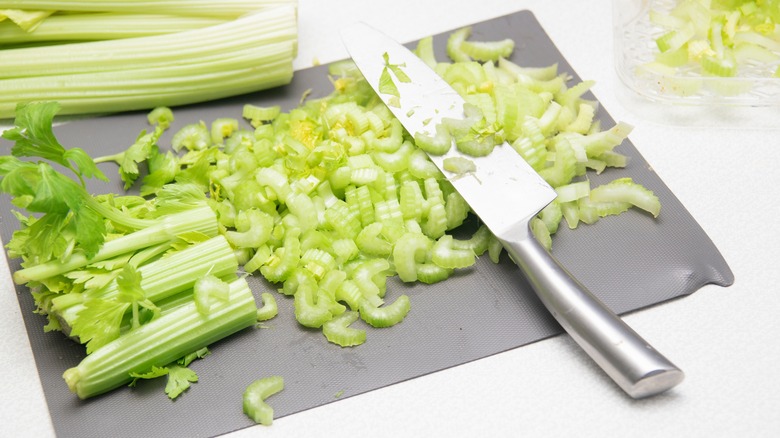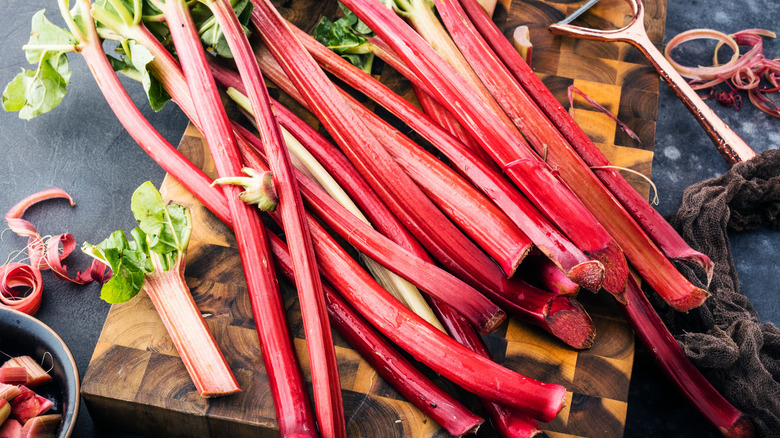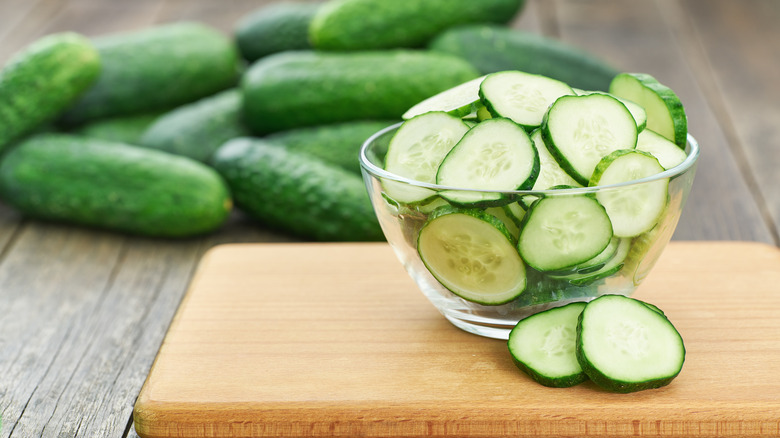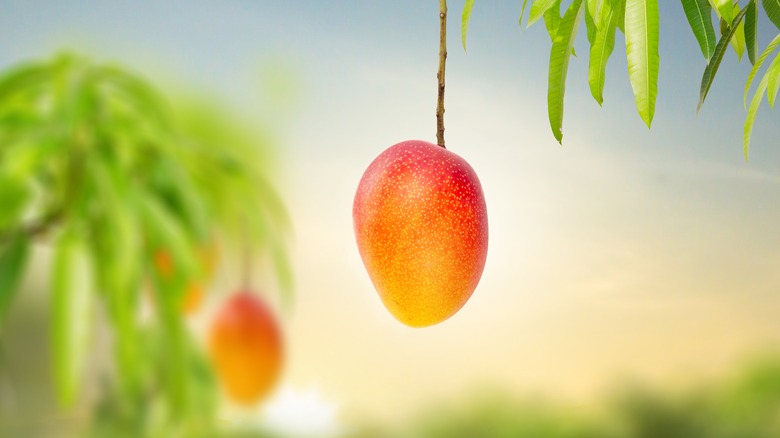The Best And Worst Foods To Put Into A Juicer
Juicing has taken the world by storm. While fruit and vegetable juices have existed on store shelves for eternity, the appeal of fresh-pressed juices and at-home juice makers has seen renewed popularity, in part for the potential health benefits you can get from the tasty beverages.
A well-made fresh juice is a superb way to get a truckload of essential vitamins and minerals in one go, with vitamins A, C, K, folate, iron, potassium, and calcium making regular appearances in juicing combinations (per WebMD). Drinking freshly-squeezed vegetable or fruit juice may also boost your nitric oxide levels, which could have a positive impact on your blood pressure and heart health.
But there's a big caveat, folks. While juicing might be a tasty way to get your nutrients, part of the reason why it's so tasty is due to the high sugar content that some juice combos can deliver, leading to spikes in blood sugar and increased calorie intake, and diminishing the healthiness of your juices. To add to this, not all fruits and vegetables are made equal texturally, and one incorrect addition could not only ruin your juice but might have you running to the store to buy a new juicer.
We want to give you the lowdown on how to get the best, healthiest juices possible, with our top foods for juicing — while also letting you know which items you should definitely avoid. Let's take a look.
Best: carrots
Next time you fire up your juicer, make sure you're throwing some carrots in. Pound-for-pound, these bright orange vegetables are pretty much the best thing you can juice, with an abundance of vitamins, minerals, and antioxidants going into your glass (per Healthline). Carrots are lower in calories, carbs, and natural sugars than many other juicing options, yet still deliver an incredibly impressive amount of vitamins A, C, and K. Vitamin A, in particular, can act to boost both your eye health and immunity, with your immune system also benefitting from the vitamin C the drink provides. Vitamin C also helps keep your skin healthy and supple.
Zeaxanthin and lutein, two antioxidants present in high quantities in carrots and their juice, can also support eye health and function, with lutein and other compounds in the vegetable also potentially having anticancer properties. On the mineral front, carrots are especially high in potassium, the essential electrolyte that's so instrumental in supporting cardiovascular health. And if that wasn't enough, drinking carrot juice may help to control blood sugar, thanks to its anti-inflammatory and probiotic effects. Enough reasons for ya?
Worst: avocados
If we were to draw up a list of the things we're most thankful for, avocados would be up there. This next-level fruit is a nutritional kingpin, delivering a truckload of vitamins, minerals, fiber, healthy omega-3 fatty acids, and antioxidants with every bite of avocado toast (per Medical News Today). But when it comes to putting them in your juicer, they very quickly lose their charm. Unfortunately, avocados are a seriously bad choice for juicing, namely because of their consistency, as Good Nature states. Simply put, avocados just don't have much juice in them, and their creamy texture means that you get very little by way of liquid.
But that's no reason to leave them in the store entirely, with the unique texture of avocados making an incredible addition to smoothies. In a blender, blitz together half an avocado with one frozen banana, a scoop of protein powder, handful of spinach or kale, and some unsweetened plain almond milk to loosen it all up, to make a super-healthy smoothie that has all of the avo's nutritional benefits, says Minimalist Baker. You can even throw in some seeds of your choice to make it even more nutritious.
Best: ginger
If you want to kick your juice into another dimension of flavor, spice, and health, ginger is the way to go. The spicy root packs an extraordinary punch and provides a range of health benefits without boosting your sugar intake. The gingerol compounds present in ginger can have a potent anti-inflammatory effect, assisting in pain management and inflammation reduction in several chronic conditions like osteoarthritis, says Medical News Today. Ginger can also have a stomach-settling effect, and may help to manage gas, indigestion, and nausea.
Ginger can have a pretty strong taste, though, so it's useful to know how to use it in juice combinations. We recommend throwing it into a green juice, as Clean Eating Kitchen suggests. Combine cucumber, celery, lemon, parsley, and ginger in a juicer, with a green apple thrown in for a little extra sweetness in the antioxidant and vitamin-packed drink. If you don't have a juicer, you can blend them all up in a blender or Nutribullet, and then strain it with a cheesecloth.
Worst: pineapples
No fruit salad is complete without the addition of pineapples, and the super-sweet fruit is as good on its own as it is in combo with other foods. Regrettably, placing it in a juicer is not the best idea. While the pineapple, in its complete form, is an incredible source of fiber and vitamins, when you juice the fruit a lot of this goodness is separated, and the pineapple juice that's left is simply a rush of pure sugar, explains Neda Varbanova, holistic health coach and certified culinary nutritionist, to The Healthy. "This can cause your blood sugar and insulin levels to spike," Varbanova says — not exactly what you want from a healthy juice.
Keeping pineapple in your diet, however, is still a great idea. The high levels of fiber you get from eating pineapple in its whole form can work wonders for your digestion, improved further by the bromelain enzymes in the fruit (per BBC Good Food). Bromelain may also deliver an anti-inflammatory effect, which may reduce symptoms of chronic conditions like osteoarthritis or bowel conditions like ulcerative colitis, as well as having a positive impact on your immune system.
Best: kale
Kale is, to repurpose the title of a late '80s rom-com, some kind of wonderful. The dark leafy green is endlessly versatile, and when it's in juice form, it really comes into its own. Throwing a few handfuls of kale into a juice with other fruits and vegetables gives you a host of nutritional benefits while not overpowering the flavor, states Healthline. Of particular note is its vitamin content, delivering a sizeable amount of vitamins A, C, and K without boosting the sugar content of a juice.
Kale is also jam-packed with antioxidants, with beta-carotene abundant in the vegetable and serving to combat free radical damage. This could have a particularly positive impact on your heart health, according to a study published in Biomedical and Environmental Sciences. Researchers looked at the impact of introducing 150 milliliters of kale juice every day for 12 weeks into the diet and found that at the end of the three months, participants' LDL cholesterol levels were significantly lower. This result bears positive implications for the long-term effects of drinking kale juice on developing cardiovascular disease, researchers concluded.
Worst: regular coconuts
There are few fruits as refreshing as the coconut, and on a hot summer's day, biting into coconut flesh is what dreams are made of. But if you're thinking about transferring that goodness to your juicer, we'd heavily advise against it. In most forms, coconuts are largely unsuitable for juicing: They're just too hard to pull the liquid out of, and you risk doing serious damage to your machine, explains All About Juicing. You can get some use of them if your juicer has a homogenize function — to make a sorbet or a coconut blend — but, naturally, you'll need to separate the flesh from the shell, which can take a lot of time.
Certain varieties of coconut, however, might be better for juicing. As young Thai coconuts are softer, they may be better suited to be used in juice, primarily due to their soft flesh. Or, try adding some coconut water to your juices. Topping off your juice with a little coconut water is an excellent way to give your drink a potassium boost, and supply your drink (and your body) with some additional electrolytes, states the Cleveland Clinic. This can be especially useful if you're drinking your juice after a hard workout.
Best: spinach
Okay, look, we know that spinach-flavored water isn't exactly some people's idea of a delicious glass of juice. But trust us when we tell you that once you know the benefits of spinach juice for your health, you'll never go back. Spinach brings a huge list of vitamins, minerals, and antioxidants to any juice, including vitamin A, folic acid, and iron, says Style Craze. The iron in the juice assists in hemoglobin production, allowing oxygen to transport around your body more effectively, and preventing anemia (per Medical News Today). Vitamin A, meanwhile, can help your body with a huge amount of functions, including maintaining a healthy immune system, boosting eye health, and supporting reproductive health (via Office of Dietary Supplements).
Additionally, the high-nitrate nature of spinach and spinach juice could be your heart health's best friend. Research published in Nitric Oxide examined the effects of consuming food high in nitrates and its effects on blood vessels and found that after a nitrate-rich meal, blood pressure was lower, and arteries were less stiff. This could have positive implications for folks who are drinking a glass of spinach juice with their evening meal.
Worst: bananas
There's a lot to love about bananas. These fiber and potassium-rich fruits can not only keep your appetite at bay, but they support your gut, benefit your cardiovascular health, and may even make you happier thanks to their tryptophan content (per BBC Good Food). One thing that won't make you happy, though, is sticking them in your juicer. The soft, mushy texture of bananas means that while they might be satisfying to eat, they won't bear much juice at all, says Greatist. The only thing you'll be left with if you stick one in your juicer is a lot of slime, and a stressful clean-up operation.
Where bananas do shine, however, is in smoothies — and there's no reason at all why a smoothie can't be healthy. Take one chopped frozen banana, and throw it into a blender with some Greek yogurt, a little milk or nondairy milk substitute, and half a peeled orange. You can also include a little sweetness if you like, by adding honey. Blend it all up, pour it into a glass, and enjoy. Not only are you getting a bounty of health benefits from the fruit in the smoothie, but the milk and Greek yogurt will give you a boost of protein, making it more filling.
Best: apples
If you need some sweetness in your juice, you can't really do much better than apples. These fruits will give a throwback of the apple juice you used to love drinking as a kid, with some healthy goodness to boot. One key selling point of using apples in your juices is their polyphenol content, which partly remains when they're run through a juicer (per Healthline). These polyphenols can be superbly beneficial to your health, with the plant compounds having a positive effect on cholesterol levels. Also, polyphenols may have anti-inflammatory effects, according to a study published in Oxidative Medicine and Cellular Longevity. And they may fight free radical damage in your brain, thereby lessening the chance of developing conditions like Alzheimer's.
However, it's not all good news. Although apples are great for making your juices a little sweeter, using too many can boost the sugar content of your drink. This sugar, and lack of fiber in the apple juice — which is stripped away when you juice it — means that drinking it can spike your blood sugar. It's worth, therefore, being prudent about how many apples you're adding to your juice, and potentially using it in more vegetable-based juices to give them a sweeter taste.
Worst: pears
On the surface, pears seem like a natural choice to place into a juicer. Juicy, sweet, and full of health-giving vitamins and flavonoids (per BBC Good Food), you'd assume that they'd fit right in, right? Well, unfortunately, pears may be a bad choice to add to a juice — but not for the reason you might expect. "Pears contain sorbitol, a non-digestible form of sugar that can create a quick bowel movement," advises holistic health coach and certified culinary nutritionist Neda Varbanova to The Healthy. "That's why many people drink pear juice to treat constipation." However, if you're not seeking to usher in a bowel movement, adding pears into a juice can quickly create an unwanted trip to the bathroom.
It's also worth bearing in mind that juicing pears will extract a lot of the sugar in the fruit, leaving you with a drink that has, potentially, a high sugar content. If you don't have a sorbitol sensitivity, however, pears could be a healthy choice on their own, but we'd advise that you eat them whole to make the most of their fiber content. Containing both soluble and insoluble fiber, eating pears may promote better appetite management, lessen the risk of developing type 2 diabetes, and keep your gut microbiota healthy, says BBC Good Food.
Best: celery
Whether you're making a soup or stew, risotto or ragu, celery will be at home in your recipe. And luckily for celery enthusiasts, it's also one of the best things you can put in your juicer. Celery juice delivers an almost absurdly long list of vitamins and minerals with each glass, including folate, vitamins A, C, and K, biotin, zinc, copper, magnesium, and calcium, says WebMD. In addition, one of the best things about celery juice is that it retains some fiber content, which is often lost when you move fruit and vegetables through the juicing process, with 4 grams of fiber per 8-ounce serving, and a few grams of protein to boot.
And other components in celery juice will have you running to the juicer even faster. Celery juice has powerful phytochemicals in every sip, which may help to bring down inflammation. The antioxidant content in celery juice could also fight against free radical damage in your body, thereby better equipping your body to prevent chronic diseases like cancer. And to top it all off, celery blends well with a host of other fruit and veggies taste-wise.
Worst: rhubarb
We think rhubarb is a truly underrated fruit (okay, it is technically a vegetable, but when was the last time you had it in savory form?). But regrettably, one place it isn't underrated is in its ability to be juiced. If you've ever tried to prepare rhubarb from its raw form, you'll likely have an idea why, folks: It's tough. Rhubarb is incredibly high in fiber, and the density and hardness of the stalks mean that if you run it through your juicer, you may cause untold damage to your machine (per the Greatist).
Don't worry if you've already come home with an armful of rhubarb, though: You can still put it to good use, in smoothie form! Take a stalk of rhubarb and cut it into 1-inch pieces, and then pop it into your blender alongside half a pint of fresh strawberries and frozen banana (per The Adventure Bite). Pour in 8 ounces of milk, or coconut milk for a little extra creaminess, and half a cup of ice. Blend it all together, and pour into a glass! You can also add a little bee pollen on top, should you wish.
Best: cucumbers
The cucumber is up there with the all-time greats of your vegetable drawer. And frankly, when it comes to juicing, it's hard to get much better than using a cucumber, both for health and textural reasons. The first bonus that cucumbers have is their water content, according to Healthline. This not only means that you'll be able to extract a lot of juice from them, but it also means they're a hydrating choice. Maintaining proper hydration is essential to almost every health consideration we have, from kidney function to our ability to exercise at full capacity, per a study published in Nutrition Reviews.
Cucumbers are also packed with electrolytes, which adds a further boost to your hydration, and makes it the perfect choice on a hot day (via Medical News Today). These electrolytes, which include potassium and magnesium, also play a role in keeping your heart healthy and reducing blood pressure and the risk of cardiovascular conditions. The vitamin K present in cucumber and its juice also improves your capacity to absorb calcium and promotes proper bone health.
Worst: mangoes
Honestly, who doesn't love mango? Often referred to as the "King of Fruits," according to The Mango Genome, it's a mineral-rich and delicious plant, high in antioxidants, that's as good on its own as it is in a dessert. When it comes to juicing, though, the mango loses it's crown. The problem with using mangoes in a juicer is not necessarily nutrition-based, but textural. (per the Greatist). Part of what makes mangoes so great is their soft flesh, but that very flesh won't give away a lot of juice if you try and run it through a machine. Instead, you'll just end up with a mango-y mash. It's worth noting that papayas, with a similar texture, have the same problem.
We implore you not to throw those mangoes out, though. Instead, make yourself a next-level mango smoothie, by combining a few fresh mangoes or some frozen mango with a frozen banana in a blender. Add half a cup of milk and yogurt each, and then blend.

